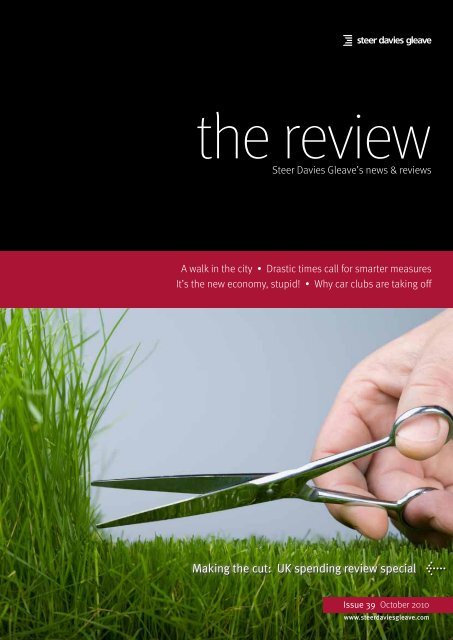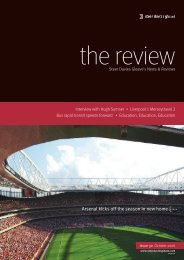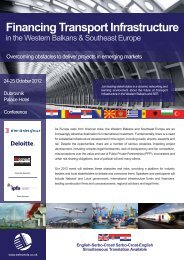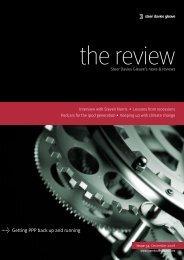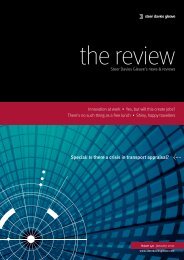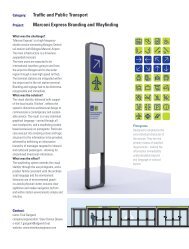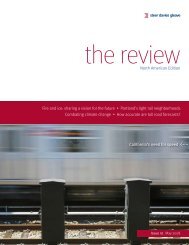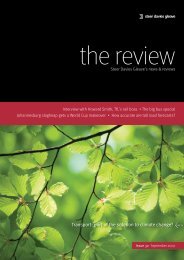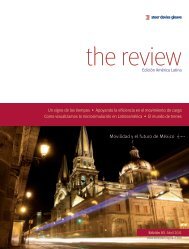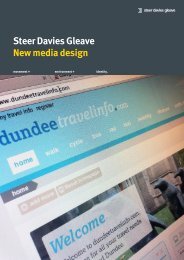Making the cut: UK spending review special - Steer Davies Gleave
Making the cut: UK spending review special - Steer Davies Gleave
Making the cut: UK spending review special - Steer Davies Gleave
Create successful ePaper yourself
Turn your PDF publications into a flip-book with our unique Google optimized e-Paper software.
<strong>the</strong> <strong>review</strong><br />
<strong>Steer</strong> <strong>Davies</strong> <strong>Gleave</strong>’s news & <strong>review</strong>s<br />
A walk in <strong>the</strong> city • Drastic times call for smarter measures<br />
It’s <strong>the</strong> new economy, stupid! • Why car clubs are taking off<br />
<strong>Making</strong> <strong>the</strong> <strong>cut</strong>: <strong>UK</strong> <strong>spending</strong> <strong>review</strong> <strong>special</strong><br />
Issue 39 October 2010<br />
www.steerdaviesgleave.com
welcome october 2010<br />
CEO’s comment<br />
We are experiencing a ‘once in a generation’<br />
shift in <strong>the</strong> priorities of our clients all<br />
around <strong>the</strong> world. Their need is to find<br />
sustainable and robust ways to deliver<br />
(new) transport policy outcomes in <strong>the</strong><br />
most cost-effective manner. This is<br />
reflected in <strong>the</strong> increasing number of<br />
commissions we have in North and South<br />
America and <strong>the</strong> Middle East developing<br />
transport and commercial solutions to<br />
deliver transport systems that underpin<br />
<strong>the</strong> objective of delivering ‘liveability’<br />
and sustainability to our cities. In <strong>the</strong> <strong>UK</strong>,<br />
<strong>the</strong> emphasis is more about improving<br />
operational and financial effectiveness<br />
given existing (or reduced) resources<br />
while still developing <strong>the</strong> major projects.<br />
Features<br />
t A walk in <strong>the</strong> city / p4-5<br />
Walking is second nature to us, so<br />
why does it play second fiddle to o<strong>the</strong>r<br />
modes as a means to get from A to B?<br />
t Pedal power / p6<br />
As <strong>the</strong> cycling culture continues<br />
to grow in <strong>the</strong> <strong>UK</strong>, we offer ways<br />
to help authorities instil and<br />
improve cycling in <strong>the</strong>ir areas.<br />
t Signs of <strong>the</strong> times / p7<br />
Once notorious for drug crime, Bogotá is<br />
now a popular destination for tourism.<br />
<strong>Steer</strong> <strong>Davies</strong> <strong>Gleave</strong>’s wayfinding<br />
strategy helps <strong>the</strong> tourists explore and<br />
learn more about this intriguing city.<br />
2<br />
This shift is a significant challenge but<br />
one that <strong>Steer</strong> <strong>Davies</strong> <strong>Gleave</strong> thrives<br />
on and we certainly have <strong>the</strong> technical<br />
expertise to underpin our strategic<br />
advice and expert opinion to help clients<br />
develop, design, deliver and procure <strong>the</strong><br />
integrated and viable solutions required.<br />
Best regards<br />
Hugh Jones and Steve Hewitt<br />
joint ceos<br />
t Into Africa / p8-9<br />
A fifth of <strong>the</strong> world’s population lives<br />
in Africa, yet for many, safe, modern<br />
and efficient transport is sorely lacking.<br />
<strong>Steer</strong> <strong>Davies</strong> <strong>Gleave</strong> has been working in<br />
four key areas to help change all that.<br />
t It’s <strong>the</strong> new economy, stupid! / p11<br />
In an economy with less funding,<br />
new tools are needed to help<br />
make <strong>the</strong> right decisions.<br />
t Why car clubs are taking off/ p12<br />
While most of its members are<br />
individuals, car clubs offer local<br />
authorities great benefits too.<br />
Not on <strong>the</strong> mailing list?<br />
Want to be sure to receive The<br />
Review regularly? If you’re not<br />
already on our mailing list, you<br />
can subscribe by going to www.<br />
steerdaviesgleave.com/subscribe<br />
t <strong>Making</strong> <strong>the</strong> <strong>cut</strong> / p13<br />
Which schemes should be <strong>cut</strong> and<br />
which ones shouldn’t? We offer local<br />
authorities four guiding principles on<br />
how to prioritise <strong>the</strong>ir transport plans.<br />
t Drastic times call for smarter<br />
measures / p14-15<br />
Unprecedented public <strong>spending</strong> <strong>cut</strong>s<br />
could just be <strong>the</strong> catalyst smarter<br />
choices need to take centre stage.
Solutions for <strong>the</strong> planet<br />
Along with Metro (West Yorkshire PTE),<br />
<strong>Steer</strong> <strong>Davies</strong> <strong>Gleave</strong> was one of this year’s<br />
business sponsors of Solutions for <strong>the</strong><br />
Planet. Working with secondary school<br />
children from across Yorkshire, <strong>the</strong> initiative<br />
promotes entrepreneurship and raises<br />
awareness of community, social and<br />
environmental issues by challenging school<br />
kids to form ‘companies’ that offer both<br />
commercial potential and a social purpose.<br />
Like any company, each team needed<br />
to work out its managerial, marketing<br />
and finance roles. Over <strong>the</strong> course of <strong>the</strong><br />
programme, each company developed<br />
its business plan by testing out <strong>the</strong><br />
feasibility of <strong>the</strong>ir proposal, developing<br />
<strong>the</strong>ir marketing strategy and working out a<br />
financial plan. Part of <strong>the</strong> process included<br />
a Young Persons Conference in March,<br />
which gave 400 kids access to experts<br />
– including Paul Robinson and Jehan<br />
Leelananda from <strong>Steer</strong> <strong>Davies</strong> <strong>Gleave</strong> who<br />
were part of <strong>the</strong> Transport Expert Zone – to<br />
help <strong>the</strong>m develop <strong>the</strong>ir ideas. The teams<br />
<strong>the</strong>n pitched <strong>the</strong>ir ideas to a panel of judges<br />
at a number of heats, with 10 going through<br />
to a Celebration Final held in <strong>the</strong> Palace<br />
of Westminster at <strong>the</strong> beginning of July.<br />
<strong>Steer</strong> <strong>Davies</strong> <strong>Gleave</strong> Director Neil Chadwick<br />
took part on <strong>the</strong> judging panels for one<br />
of <strong>the</strong> heats and <strong>the</strong> Westminster final.<br />
“The energy and enthusiasm of all <strong>the</strong><br />
finalists was inspiring”, he said. “Their<br />
hard work, preparation and passion was<br />
clear to see. As well as putting forward<br />
ideas to promote sustainability, <strong>the</strong>y<br />
showed real business acumen too.”<br />
This year’s winners were Yoob It! – a team<br />
of three from City of Leeds School whose<br />
big idea was to bridge <strong>the</strong> generation<br />
gap by using technology to put young<br />
people in touch with older members of <strong>the</strong><br />
community who wanted help with odd jobs.<br />
New head of Latin America<br />
We have grown rapidly<br />
in Central and South<br />
America in recent years,<br />
opening offices in Mexico<br />
and Brazil and developing<br />
a wide portfolio of work<br />
in toll roads, public<br />
transport and stadia.<br />
Following Gloria Hutt’s appointment to<br />
<strong>the</strong> Chilean government, we are delighted<br />
with <strong>the</strong> leadership that Germán Lleras<br />
has been providing as our new head<br />
of Latin America. Germán is working<br />
with our offices in Bogotá, Mexico City,<br />
Santiago, San Juan and São Paulo to<br />
continue to expand <strong>the</strong> range of work we<br />
do in <strong>the</strong> region as well as our teams.<br />
september 2010 news in brief<br />
Free autumn<br />
seminar series<br />
Challenges for local transport<br />
in an age of austerity<br />
The outcome of <strong>the</strong> <strong>UK</strong> government<br />
<strong>spending</strong> <strong>review</strong> is due to be<br />
announced on 20 October. To create<br />
a dialogue on key aspects of <strong>the</strong> new<br />
transport planning agenda, we have<br />
been running a series of seminars with<br />
RTPI and TPS. Come along to hear <strong>the</strong><br />
views of respected experts, and add<br />
your own voice to <strong>the</strong> debate.<br />
8 september<br />
Integrating transport with<br />
o<strong>the</strong>r key outcomes: How to<br />
evaluate effectiveness in terms<br />
of achieving wider policy goals<br />
15 september<br />
Citizen involvement in prioritisation:<br />
Ensuring tough decisions<br />
are made democratically,<br />
equitably and transparently<br />
22 september<br />
<strong>Making</strong> tough decisions in <strong>the</strong><br />
light of <strong>cut</strong>s to bus subsidy<br />
29 september<br />
Low-cost innovation in transport:<br />
The role of cycling, walking<br />
and community transport<br />
6 october<br />
Prioritising programmes<br />
and phasing schemes<br />
13 october<br />
Providing an Evidence Base<br />
at Low- or No-cost<br />
For more information or to register,<br />
go to www.steerdaviesgleave.com/<br />
aboutUs/Autumn_seminar_series<br />
3
A walk in <strong>the</strong> city<br />
Walking is second nature to us, so why does it play second fiddle<br />
to o<strong>the</strong>r modes as a means to get from A to B?<br />
By Tony Duckenfield<br />
Why does <strong>the</strong> saying<br />
go ‘a walk in <strong>the</strong> park’<br />
and not ‘a walk in <strong>the</strong><br />
city’? Why is it that<br />
even for short trips,<br />
do most of us opt for<br />
a different mode to<br />
transport us ra<strong>the</strong>r<br />
than our own two feet? Can <strong>the</strong>re be<br />
any more potential to get more people<br />
to walk more? Surely, if a trip could<br />
be walked it would be walked?<br />
What we have found, as illustrated in<br />
figure 1, is that many walkable trips<br />
(two miles or less) are currently made by<br />
car or bus. For example, for trips up to<br />
a mile, walking is indeed <strong>the</strong> dominant<br />
mode, however, less than a third of trips<br />
between one and two miles in length are<br />
currently walked, and less than one in ten<br />
trips of two to three miles. As with many<br />
things dealing with human behaviour,<br />
<strong>the</strong>re are several reasons why this is.<br />
The barriers to walking<br />
A key factor is habit: many people are just<br />
too used to automatically getting into <strong>the</strong>ir<br />
car to make a trip, irrespective of how long<br />
it is. This avoids <strong>the</strong> need to worry about<br />
how to make <strong>the</strong> trip or how long it will take;<br />
using car for everything makes life simple.<br />
Linked to this is a lack of understanding<br />
about distances and times when walking.<br />
If car is always used, it can be hard to<br />
imagine how long a journey would take<br />
by foot, and <strong>the</strong> impression can be that<br />
it is bound to be too far. The same can<br />
be true of journeys by public transport:<br />
4<br />
market research walking<br />
sometimes walking can be dismissed<br />
as an option far too easily because we<br />
are too used to mechanised modes.<br />
A specific issue in London, which may be<br />
relevant in a different guise in o<strong>the</strong>r places,<br />
is <strong>the</strong> inaccurate mental map created by<br />
<strong>the</strong> London Underground schematic. This<br />
makes many places in central London seem<br />
fur<strong>the</strong>r away than <strong>the</strong>y actually are. To some<br />
extent this effect is created by <strong>the</strong> sheer<br />
density of central London, and this is also<br />
true of many o<strong>the</strong>r urban centres. In o<strong>the</strong>r<br />
words, people think about distance in terms<br />
of <strong>the</strong> number of landmarks <strong>the</strong>y need to<br />
go past, so lots of landmarks can make<br />
it feel like it’s fur<strong>the</strong>r than it actually is, if<br />
<strong>the</strong>se landmarks are crammed into a small<br />
area. Unfamiliarity also has an impact, with<br />
familiarity making things seem closer.<br />
Figure 1: Mode Shares for Short Trips<br />
100%<br />
90%<br />
80%<br />
70%<br />
60%<br />
50%<br />
40%<br />
30%<br />
20%<br />
10%<br />
0%<br />
20%<br />
76%<br />
Source: National Travel Survey 2002-4<br />
57%<br />
31%<br />
O<strong>the</strong>r barriers include <strong>the</strong> need to carry<br />
equipment, luggage, or shopping; <strong>the</strong><br />
wea<strong>the</strong>r; being able to find <strong>the</strong> best<br />
route; and feelings of personal insecurity.<br />
Some of <strong>the</strong>se can be overcome, and<br />
some only apply to specific trips so<br />
<strong>the</strong>se do not negate <strong>the</strong> potential for<br />
walking entirely, it may just reduce<br />
<strong>the</strong> scope somewhat and make it<br />
more difficult to change behaviour.<br />
Encouraging walking<br />
To encourage significantly more walking<br />
requires understanding <strong>the</strong> specifics of a<br />
location: what are <strong>the</strong> types of trips being<br />
made? Who is making <strong>the</strong>m? What are<br />
<strong>the</strong> barriers to walking? Fortunately <strong>the</strong>re<br />
are some off-<strong>the</strong>-shelf techniques which<br />
can greatly speed up (and reduce <strong>the</strong><br />
cost of) gaining this market knowledge.<br />
9% 3%<br />
Under 1 mile to under 2 mile to under 3 mile to under 5 mile<br />
trip length<br />
74%<br />
77%<br />
O<strong>the</strong>r<br />
Bus<br />
Car<br />
Cycle<br />
Walk
For looking at <strong>the</strong> demand side,<br />
we can use our Smarter TravelStyle<br />
profiling and segmentation tool, which<br />
provides an understanding of <strong>the</strong> types<br />
of people living in an area and <strong>the</strong><br />
types of measures that are likely to be<br />
effective in changing <strong>the</strong>ir behaviour.<br />
For evaluating <strong>the</strong> supply side and <strong>the</strong><br />
need for improvements to <strong>the</strong> walking<br />
infrastructure, <strong>the</strong>re is <strong>the</strong> Pedestrian<br />
Environmental Review System (PERS )<br />
system which involves auditing walking<br />
routes. An attraction of this system is that it<br />
quantifies <strong>the</strong> problems and <strong>the</strong> potential<br />
benefits: very useful for justifying funding.<br />
Having established <strong>the</strong> relevant<br />
understanding, a walking strategy<br />
can be developed incorporating<br />
an appropriate mixture of ‘hard’<br />
and ‘soft’ measures such as:<br />
hard soft<br />
Signage<br />
Removing<br />
street clutter<br />
Pedestrianisation /<br />
Pedestrian priority<br />
Walking<br />
maps<br />
Marketing<br />
communication<br />
campaigns<br />
Personalised<br />
Travel Planning<br />
A good strategy will also have quantified<br />
targets for additional volumes of walking<br />
and/or increased walking mode share,<br />
which in turn will enable <strong>the</strong> strategy to<br />
be evaluated and justified, potentially<br />
using a formal business case approach.<br />
Walking as a transport mode does seem<br />
to be taken for granted and to play<br />
second fiddle to higher-profile modes<br />
like cycling, tram and rail. But in <strong>the</strong> <strong>UK</strong>’s<br />
current <strong>spending</strong> climate it may be that<br />
walking can provide <strong>the</strong> relatively low-cost<br />
‘quick wins’ that many are looking for.<br />
To find out more contact<br />
Tony Duckenfield<br />
t +44 (0)20 7910 5000<br />
e tony.duckenfield@sdgworld.net<br />
London by foot<br />
market research walking<br />
<strong>Steer</strong> <strong>Davies</strong> <strong>Gleave</strong> is currently<br />
undertaking <strong>the</strong> post-evaluation of<br />
a major pilot of <strong>the</strong> ‘Legible London’<br />
wayfinding pedestrian scheme. Based<br />
on extensive research, <strong>the</strong> scheme<br />
uses a range of information such as<br />
signs and printed maps to help people<br />
find <strong>the</strong>ir way around London by foot.<br />
Initial signs are positive and it will be<br />
interesting to see <strong>the</strong> full results when<br />
<strong>the</strong>y emerge later in <strong>the</strong> autumn.<br />
(CC) Adam NFK Smith 2010<br />
5
policy and planning cycling<br />
Pedal power<br />
As <strong>the</strong> cycling culture continues to grow in <strong>the</strong> <strong>UK</strong>, we offer ways<br />
to help authorities instil and improve cycling in <strong>the</strong>ir areas.<br />
By Pete Zanzottera<br />
It’s not just <strong>the</strong> recent<br />
launch of London’s new<br />
cycle hire scheme; <strong>the</strong><br />
momentum behind<br />
cycling has steadily been<br />
building over <strong>the</strong> last<br />
several years in <strong>the</strong> <strong>UK</strong>.<br />
Journeys by cycle in <strong>the</strong><br />
capital have doubled in <strong>the</strong> last decade.<br />
The Cycling Town initiative has increased<br />
cycling in <strong>the</strong> participating towns by 27%<br />
on average in just three years. With political<br />
backers and cycling enthusiasts such as<br />
Johnson, Villiers, Baker and Mr Cameron<br />
himself, cycling remains high on <strong>the</strong><br />
government’s agenda. And as a relatively<br />
low-cost means to achieve transport<br />
objectives, now is a real opportunity to<br />
push <strong>the</strong> bike out even fur<strong>the</strong>r. Here are<br />
a few ways <strong>Steer</strong> <strong>Davies</strong> <strong>Gleave</strong> can help<br />
develop cycling strategies for local areas:<br />
Getting audited<br />
Many cities and towns have some routes<br />
but few have a well-connected and<br />
differentiated network that is coherent and<br />
easy to understand. Using cycle-based<br />
video analysis, connected to GPS and<br />
o<strong>the</strong>r sensors, we can conduct extensive<br />
and detailed audits on cycle networks.<br />
6<br />
For example, in Potters Bar, we have<br />
used <strong>the</strong>se methods to capture all of <strong>the</strong><br />
roads and potential routes to classify <strong>the</strong><br />
existing network according to <strong>the</strong> three<br />
Bikeability training levels (based on<br />
cyclists’ experience and confidence):<br />
t level 1 – off-road and traffic-free routes<br />
t level 2 – light-trafficked roads<br />
and residential areas<br />
t level 3 – busier roads with<br />
higher levels of traffic<br />
Improving networks<br />
Working out suggested improvements<br />
to <strong>the</strong> networks and prioritising <strong>the</strong>m is<br />
something that we understand completely.<br />
In some cases this may involve developing<br />
a full business case and generating cost<br />
benefit analysis figures. Generally <strong>the</strong> costs<br />
to build a network are relatively easy to<br />
calculate and it is possible to put forward<br />
a set of improvements that could be built<br />
quickly. Calculating benefits for cycle<br />
routes is more complex and very sensitive<br />
to <strong>the</strong> number of existing cyclists and <strong>the</strong><br />
estimate of new cyclists. Our work focuses<br />
on improving <strong>the</strong> connectivity of a cycle<br />
network and providing ‘missing links’ that<br />
will help to encourage more people to cycle.<br />
Mapping it out<br />
Featured in <strong>the</strong> last issue of The Review,<br />
our new Cycling Potential Index (CPI) tool<br />
visually displays an area’s underlying<br />
attractiveness for cycling in terms of<br />
topography, demographics and potential<br />
usage. The results can be overlaid on<br />
network improvements to help judge where a<br />
cycle route or network will be most effective.<br />
Getting into <strong>the</strong>ir heads<br />
In addition, having insight into <strong>the</strong><br />
behaviour of cycling – who does it, why,<br />
where and when – is invaluable when<br />
trying to promote and encourage new<br />
cycling schemes. <strong>Steer</strong> <strong>Davies</strong> <strong>Gleave</strong> has<br />
undertaken innovative research and analysis<br />
regarding projects such as <strong>the</strong> London Cycle<br />
Hire Scheme and Cycle Superhighways.<br />
This work has particularly focused on<br />
route alignments, user profiles, potential<br />
demand and uptake of proposed work and<br />
home-end Smarter Travel measures.<br />
To find out more contact<br />
Pete Zanzottera<br />
t +44 (0) 113 389 6400<br />
e pete.zanzottera@sdgworld.net
Signs of <strong>the</strong> times<br />
Once notorious for drug crime, Bogotá is now a popular destination for tourism. <strong>Steer</strong> <strong>Davies</strong><br />
<strong>Gleave</strong>’s wayfinding strategy helps <strong>the</strong> tourists explore and learn more about this intriguing city.<br />
By Juan Pablo Rioseco<br />
While years of political<br />
instability once<br />
made it a place to be<br />
avoided, improved<br />
security, infrastructure<br />
projects and clean-up<br />
campaigns, have made<br />
Bogotá one of Latin<br />
America’s urban highlights, attracting<br />
over 630,000 tourists last year.<br />
To help tourists navigate <strong>the</strong>ir way<br />
around <strong>the</strong> city, <strong>Steer</strong> <strong>Davies</strong> <strong>Gleave</strong><br />
was asked by Bogotá’s tourism board to<br />
develop a wayfinding strategy including<br />
a commemorative trail around <strong>the</strong><br />
historical city centre of La Candelaria<br />
for <strong>the</strong> country’s Bicentennial, which<br />
celebrates <strong>the</strong> 200th anniversary of its<br />
independence from Spain this year.<br />
La Candelaria is an intriguing<br />
neighbourhood of cobblestone streets,<br />
historical squares and 400-year-old<br />
churches mixed with cafes, hotels<br />
and modern high rises. Conscious of<br />
<strong>the</strong> unique urban environment, it was<br />
important that <strong>the</strong> signing system for<br />
<strong>the</strong> Bicentennial trail was clearly visible<br />
yet respectful of its surroundings.<br />
Following visual and accessibility audits<br />
to understand <strong>the</strong> flow of pedestrians, we<br />
created a two-mile pedestrian route linking<br />
38 landmarks which reconciled historic<br />
accuracy and wayfinding opportunities<br />
into a sequence of numbered items. The<br />
trail can be followed regardless of where<br />
someone might join <strong>the</strong> trail, capturing both<br />
incidental citizens and tourists wandering<br />
around <strong>the</strong> area, as well as offering better<br />
support to organised tour groups.<br />
The signage itself needed to serve several<br />
purposes: it needed to highlight <strong>the</strong><br />
Bicentennial celebrations while also having<br />
a long-lasting presence, be plainly visible<br />
and provide clear and easy-to-follow<br />
directions, as well as information about <strong>the</strong><br />
historical landmarks – while working within<br />
a wider visual identity. So we developed a<br />
combination of temporary signing elements<br />
(such as balloons, banners and totems),<br />
which specifically highlight <strong>the</strong> Bicentennial<br />
over a six-month period; and permanent<br />
waymarkers made of bronze and stainless<br />
steel, which would serve as long-lasting<br />
footprints of <strong>the</strong> celebrations. Supporting<br />
this is a comprehensive pocket guide.<br />
Signing systems aren’t just about providing<br />
directions; <strong>the</strong>y are part of <strong>the</strong> user’s wider<br />
experience of making a journey and, as in<br />
this case, discovering more about a place.<br />
The wayfinding strategy for La Candeleria<br />
gives visitors to Bogotá an insight into <strong>the</strong><br />
city’s remarkable history while allowing<br />
<strong>the</strong>m to easily and confidently explore<br />
<strong>the</strong> city that it has become today.<br />
To find out more contact<br />
Juan Pablo Rioseco<br />
t +44 (0)20 7910 5000<br />
e juan.rioseco@sdgworld.net<br />
Leaving an (in)visible mark on Bogotá<br />
Often <strong>the</strong> best wayfinding strategies go<br />
unnoticed by those using it – intuitively<br />
anticipating where people would need<br />
information to find <strong>the</strong>ir way so <strong>the</strong>y<br />
don’t even have to think about it. If<br />
someone gets confused and feels lost<br />
or frustrated, <strong>the</strong>n we haven’t done<br />
our jobs properly. <strong>Steer</strong> <strong>Davies</strong> <strong>Gleave</strong><br />
has worked on several information<br />
design and wayfinding projects in<br />
Bogotá including comprehensive<br />
passenger information and station<br />
signing guidelines for TransMilenio,<br />
one of <strong>the</strong> most successful BRT<br />
systems ever built (which we also<br />
helped design). Most recently, we’ve<br />
won a project for Bogotá’s Integrated<br />
Public Transport System aimed at<br />
bringing buses, BRT and metro toge<strong>the</strong>r<br />
into a coordinated information user<br />
experience. While we’ll definitely be<br />
leaving our ‘mark’ on <strong>the</strong> city, we’re<br />
hoping that anyone travelling in and<br />
around Bogotá won’t even realise it.<br />
7
spotlight africa<br />
Into Africa<br />
By Charles Russell<br />
A fifth of <strong>the</strong> world’s population lives in Africa, yet for many,<br />
safe, modern and efficient transport is sorely lacking. Over<br />
<strong>the</strong> last three decades, we have been working in four key<br />
areas to help change all that. Highlighted on <strong>the</strong> map are<br />
just a few of <strong>the</strong> projects we’re proud to have worked on.<br />
urban transport<br />
As <strong>the</strong> population of many African cities<br />
explodes, <strong>the</strong> pressure on <strong>the</strong> infrastructure<br />
grows to intolerable levels – in transport as<br />
with o<strong>the</strong>r key services. Transit solutions<br />
play a crucial role in enabling <strong>the</strong> cities to<br />
grow in an efficient and sustainable way.<br />
regulation and institutional<br />
development<br />
Transport services cannot be created<br />
without efficient institutional structures<br />
and effective – but permissive – regulation.<br />
These provide a clear interface between <strong>the</strong><br />
public and <strong>the</strong> private sectors, both in terms<br />
of project development and service delivery.<br />
privately financed infrastructure<br />
Transforming international capital funds into<br />
well-constructed, operated and maintained<br />
systems is a challenge many countries face.<br />
Private finance has proven to be a viable<br />
mechanism – it provides new sources of<br />
capital funding, reinforces a structure for<br />
procurement of cost-effective and timely<br />
construction, and creates an ongoing<br />
commitment to operation of <strong>the</strong> system.<br />
aviation<br />
Airports and air services are a vital part<br />
of <strong>the</strong> continuing economic development<br />
across Africa. Safe, efficient operations<br />
(through <strong>the</strong> management of airspace to<br />
<strong>the</strong> highest international standards) and<br />
modern infrastructure are needed to help<br />
ensure a bright future for <strong>the</strong> continent.<br />
8<br />
To find out more contact<br />
charles.russell@sdgworld.net<br />
abidjan, côte d’ivoire<br />
It has, for many years, been an ambition<br />
to build <strong>the</strong> Marcory bridge across<br />
<strong>the</strong> lagoon in Abidjan and connect<br />
expanding north and south without<br />
transiting <strong>the</strong> congested CBD. We<br />
have supported <strong>the</strong> scheme sponsor<br />
in developing <strong>the</strong> proposals for a<br />
toll-financed private development.<br />
gambia<br />
guinea-bissau<br />
senegal<br />
sierra<br />
leone<br />
guinea<br />
liberia<br />
morocco<br />
rabat, morocco<br />
The Ministry of Transport in Rabat wanted<br />
western<br />
to look at <strong>the</strong> possibility sahara of introducing<br />
private finance to <strong>the</strong> development and<br />
maintenance of <strong>the</strong> Kingdom’s road<br />
network. <strong>Steer</strong> <strong>Davies</strong> <strong>Gleave</strong> carried out<br />
mauritania<br />
a detailed study of how this could be<br />
structured, and gauged <strong>the</strong> domestic and<br />
international appetite for such a scheme.<br />
côted’ivoire<br />
lagos, nigeria<br />
Traffic conditions in Nigeria’s<br />
commercial centre – Lagos – are<br />
known to be chaotic, with particular<br />
bottlenecks on <strong>the</strong> bridges across<br />
to Lagos Island. We helped Lagbus<br />
establish a new company which was<br />
charged to develop and operate high<br />
quality bus services in a segregated<br />
highway along <strong>the</strong> main corridors.<br />
cape town, south africa<br />
<strong>Steer</strong> <strong>Davies</strong> <strong>Gleave</strong> has for a number of<br />
years been supporting a consortium of<br />
domestic and international contractors<br />
as <strong>the</strong>y develop proposals for <strong>the</strong><br />
extension of <strong>the</strong> major highways<br />
serving Cape Town. The latest projects<br />
will incorporate <strong>the</strong> open road<br />
electronic toll collection systems now<br />
being installed across <strong>the</strong> country.<br />
burkina faso<br />
ghana<br />
mali<br />
togo<br />
benin<br />
alg
eria<br />
nigeria<br />
equatorial guinea<br />
tunisia<br />
kigali, rwanda<br />
Kigali’s rapid growth in recent years<br />
has created a surge in demand at <strong>the</strong><br />
libyan<br />
principal regional arab bus jamahiriya and minibus taxi<br />
station at Nyabugogo, which was built 15<br />
years ago. To help ease <strong>the</strong> congestion,<br />
we provided operational and traffic<br />
advice which supported an assessment<br />
of niger <strong>the</strong> potential to attract market-based<br />
domestic finance to fund a new terminal<br />
chad<br />
appropriate to <strong>the</strong> needs of <strong>the</strong> city.<br />
sao tome<br />
and principe<br />
cameroon<br />
gabon<br />
central<br />
african republic<br />
congo<br />
democratic<br />
republic of <strong>the</strong><br />
congo<br />
durban, south africa angola<br />
In order to encourage <strong>the</strong> development<br />
of direct long distance passenger<br />
services – and to create a production<br />
and distribution hub – Kwa Zulu Natal<br />
has developed a major new airport to<br />
serve Durban. We helped establish<br />
namibia<br />
<strong>the</strong> PPP procurement of <strong>the</strong> project.<br />
botswana<br />
south africa<br />
egypt<br />
rwanda<br />
zambia<br />
zimbabwe<br />
lesotho<br />
kigali, rwanda<br />
As it rebuilds its economy after <strong>the</strong> 1994<br />
genocide, <strong>the</strong> Rwanda government needs<br />
to ensure that <strong>the</strong> major international<br />
airport at Kigali is adequate to serve <strong>the</strong><br />
country’s growing needs. <strong>Steer</strong> <strong>Davies</strong><br />
<strong>Gleave</strong> has supported <strong>the</strong> development<br />
of plans for <strong>the</strong> new airport.<br />
burundi<br />
sudan<br />
uganda<br />
ethiopia<br />
united republic of<br />
tanzania<br />
malawi<br />
mozambique<br />
eritrea<br />
kenya<br />
somalia<br />
maputo, mozambique<br />
Maputo serves as a major port for traffic<br />
from <strong>the</strong> Johannesburg/Pretoria and<br />
Nelspruit corridor. We worked with <strong>the</strong><br />
promoters to develop a major tolled<br />
highway running across <strong>the</strong> border<br />
from South Africa to <strong>the</strong> coast.<br />
spotlight africa<br />
lake albert, uganda<br />
Located on <strong>the</strong> border with Congo, Lake<br />
Albert serves both as a resource and a<br />
highway for <strong>the</strong> fishing villages located<br />
along its banks. We supported InfraCo<br />
in its appraisal of <strong>the</strong> possibility of a<br />
micro project for <strong>the</strong> development of<br />
a new ferry service across <strong>the</strong> lake.<br />
kampala – mombasa<br />
Uganda depends in great part on <strong>the</strong><br />
transport corridor between Kampala<br />
and <strong>the</strong> Indian Ocean at Mombasa.<br />
<strong>Steer</strong> <strong>Davies</strong> <strong>Gleave</strong> helped explore<br />
<strong>the</strong> possibility of developing a<br />
unitised train operation to offer a<br />
more reliable and quicker service.<br />
dar es salaam, tanzania<br />
The government-owned bus company<br />
in Dar es Salaam has found it<br />
impossible to compete in <strong>the</strong> new<br />
deregulated environment. <strong>Steer</strong> <strong>Davies</strong><br />
<strong>Gleave</strong> helped with <strong>the</strong> privatisation<br />
of <strong>the</strong> company, as well as <strong>the</strong><br />
reorganisation of <strong>the</strong> bus services.<br />
johannesburg, south africa<br />
The 60km corridor between<br />
Johannesburg and Pretoria serves<br />
more than 100,000 vehicles per day.<br />
To provide an alternative, public<br />
transport service, as well as a link<br />
to <strong>the</strong> airport, a new high-speed<br />
rail –Gautrain – is being developed.<br />
<strong>Steer</strong> <strong>Davies</strong> <strong>Gleave</strong> has provided<br />
support to <strong>the</strong> scheme developer.<br />
9
<strong>special</strong> uk <strong>spending</strong> <strong>review</strong><br />
The outcome of <strong>the</strong> <strong>UK</strong> government’s <strong>spending</strong> <strong>review</strong><br />
this autumn will have a dramatic impact on <strong>the</strong> way<br />
transport is planned, financed, delivered and operated<br />
across <strong>the</strong> country. New thinking, new tools and new<br />
ways of working are needed in an economic climate<br />
where scarce resources will have to work smarter<br />
and harder than ever before. In <strong>the</strong> following pages,<br />
<strong>Steer</strong> <strong>Davies</strong> <strong>Gleave</strong> offers some ideas to consider.<br />
10<br />
making<br />
<strong>cut</strong> <strong>the</strong><br />
uk <strong>spending</strong> <strong>review</strong>
It’s <strong>the</strong> new economy, stupid!<br />
In an economy with less funding, new tools are<br />
needed to help make <strong>the</strong> right decisions.<br />
By Lars Rognlien<br />
The current economic<br />
climate, with sluggish<br />
growth and severely<br />
constrained public<br />
purses, demands a<br />
change in <strong>the</strong> way<br />
transport projects are<br />
prioritised. With less<br />
money to go around, local authorities<br />
and central government departments<br />
alike need to consider carefully how<br />
to extract <strong>the</strong> most value for money<br />
out of <strong>the</strong> resources <strong>the</strong>y have.<br />
For transport this will most likely mean a<br />
stronger focus on revenue schemes and<br />
quick wins/ low cost options such as<br />
smarter choices and travel planning. The<br />
need for private funding arrangements may<br />
also be on <strong>the</strong> rise, although <strong>the</strong> appetite<br />
for investment may not be as great.<br />
However, if <strong>the</strong> current economy means<br />
a change in how limited funds should be<br />
prioritised, should not also <strong>the</strong> way we<br />
assess and prioritise projects change to<br />
reflect that? Two key economic challenges<br />
are restoring growth and reducing <strong>the</strong><br />
public debt, so schemes that deliver<br />
productivity gains quickly should be given<br />
a higher priority than those that deliver<br />
consumer benefits that are spread over a<br />
long period of time. Firstly, schemes that<br />
deliver economic growth quickly aid <strong>the</strong><br />
recovery. But more importantly, economic<br />
growth means sorely needed tax revenues.<br />
At <strong>the</strong> same time, partnerships of<br />
councils will replace <strong>the</strong> regional<br />
administrations. This will increase <strong>the</strong><br />
focus on understanding <strong>the</strong> local economic<br />
impacts of schemes. Councils may care<br />
less about delivering time savings and<br />
national value for money and more<br />
about growth in local employment,<br />
population, productivity and land values.<br />
All this requires new tools. The guidance<br />
on Wider Impacts can help to an extent,<br />
but only at a national level. There are<br />
regional models that can help but <strong>the</strong>se<br />
are typically costly to set up and maintain.<br />
Wanting to help fill <strong>the</strong> gap between<br />
national appraisal and bespoke regional<br />
models, we have developed a sub-regional<br />
economic impacts model. Technically it<br />
falls within a class of economic models<br />
called Computable Generalised Equilibrium<br />
(CGE) model. It represents detailed<br />
interactions between economic sectors<br />
and households in a given area, as well<br />
as trade with o<strong>the</strong>r parts of <strong>the</strong> world.<br />
This type of model has strong foundations<br />
in how economists believe actors in <strong>the</strong><br />
economy interact, where prices adjust to<br />
ensure supply and demand are in balance.<br />
Based on standard outputs from transport<br />
appraisal and published official statistics,<br />
<strong>the</strong> model can help to understand how<br />
a scheme affects <strong>the</strong> economy ‘on<br />
<strong>the</strong> ground’. Time savings to business<br />
travellers, for instance, are converted into<br />
productivity gains to <strong>the</strong> firms employing<br />
<strong>the</strong>m – giving a boost to <strong>the</strong>ir production.<br />
This in turn forces a reduction in prices,<br />
which ensures demand for <strong>the</strong>ir products<br />
keeps up. In order to increase production,<br />
<strong>the</strong> firms will increase <strong>the</strong> use of labour<br />
and o<strong>the</strong>r inputs, bidding up <strong>the</strong> price<br />
for those. Households are better off<br />
because of a combination of higher real<br />
wages, lower prices and, ultimately,<br />
higher consumption. The final outcome<br />
is a composite of all <strong>the</strong>se effects.<br />
The new model will not<br />
find any ‘new’ benefits<br />
that <strong>the</strong> appraisal did<br />
not capture. But it will<br />
give us an understanding<br />
of <strong>the</strong> distribution of impacts<br />
<strong>special</strong> uk <strong>spending</strong> <strong>review</strong><br />
across space and economic sectors<br />
(including households) as well as <strong>the</strong><br />
manifestation of <strong>the</strong> benefits in terms of<br />
prices, wages, output, jobs and incomes.<br />
With this model we will be able to<br />
advise local and regional stakeholders<br />
about how individual projects deliver<br />
against <strong>the</strong>ir economic objectives as<br />
well as helping <strong>the</strong>m demonstrate how<br />
schemes deliver economic growth and<br />
tax dividends at a national level.<br />
To find out more contact<br />
Lars Rognlien<br />
t +44 (0)20 7910 5000<br />
e lars.rognlien@sdgworld.net<br />
11
<strong>special</strong> uk <strong>spending</strong> <strong>review</strong><br />
3 reasons why car clubs are taking off<br />
While most of its members are individuals, car clubs offer local authorities great benefits too.<br />
By Mat<strong>the</strong>w Clark<br />
It’s good for <strong>the</strong><br />
environment<br />
Evidence from <strong>the</strong> Carplus<br />
annual survey 2009/2010<br />
shows that, on average,<br />
for every car club car,<br />
11 private vehicles have<br />
been sold. Car club<br />
members tend to make a greater proportion<br />
of trips by more sustainable modes than<br />
average. The reduction in car mileage by<br />
car club members also has a positive effect<br />
on emission levels, with car trips by club<br />
members producing only a quarter of <strong>the</strong><br />
emissions of a typical British licence holder.<br />
It makes political sense<br />
Encouraging sustainable travel is an<br />
area of policy which <strong>the</strong> <strong>UK</strong>’s new coalition<br />
government is keen to promote. When<br />
considering policy options for increasing<br />
sustainable travel, local authorities<br />
will increasingly need to focus on value<br />
for money. One way to tackle both <strong>the</strong><br />
need to conserve financial resources<br />
and promote increased travel by public<br />
transport, walking and cycling, is to<br />
explore partnerships with commercial car<br />
club operators. Which brings us onto…<br />
12<br />
It’s a win-win situation<br />
Car clubs provide a perfect<br />
opportunity for a partnership between<br />
<strong>the</strong> public sector and <strong>the</strong> private sector.<br />
Local authorities looking to develop a car<br />
club network can also lead by example,<br />
benefiting from using car club cars for<br />
<strong>the</strong>ir own travel, replacing <strong>the</strong> hassle and<br />
cost of maintaining fleet cars with car club<br />
cars on site. Sophisticated management of<br />
car club bookings makes it straightforward<br />
for different departments to be billed<br />
separately, while <strong>the</strong> all-inclusive cost of<br />
bookings makes costs transparent and<br />
encourages consideration of <strong>the</strong> use of<br />
o<strong>the</strong>r modes, such as train and bus travel<br />
where possible. Car clubs can potentially<br />
provide a ‘win-win’ situation for local<br />
authorities. A successfully implemented<br />
and promoted car club network can<br />
provide a local authority with both an<br />
incentive for residents to reconsider <strong>the</strong>ir<br />
car use patterns and a way to increase <strong>the</strong><br />
efficiencies and green credentials of<br />
its car fleet.<br />
So will it work for your area?<br />
As with all types of transport, <strong>the</strong> success<br />
of a car club within a particular location<br />
will vary. Car clubs are most successful<br />
commercially where population density<br />
is high, public transport is good and local<br />
authorities are supportive. <strong>Steer</strong> <strong>Davies</strong><br />
<strong>Gleave</strong> recently completed a car club<br />
market study for <strong>the</strong> London Boroughs of<br />
Camden and Islington, which considered<br />
<strong>the</strong> maximum potential for car clubs,<br />
bringing toge<strong>the</strong>r information about car<br />
club members, population demographics,<br />
and travel patterns. This study provided<br />
an evidence base to help with a planned,<br />
managed and informed expansion of car<br />
club provision across <strong>the</strong> two boroughs.<br />
To find out more contact<br />
Mat<strong>the</strong>w Clark<br />
t +44 (0)20 7910 5000<br />
e mat<strong>the</strong>w.clark@sdgworld.net
<strong>Making</strong> <strong>the</strong> <strong>cut</strong><br />
Which schemes should be <strong>cut</strong> and which ones shouldn’t? <strong>Steer</strong> <strong>Davies</strong> <strong>Gleave</strong> offers<br />
local authorities four guiding principles on how to prioritise <strong>the</strong>ir transport plans.<br />
By Tom Higbee<br />
Funding <strong>cut</strong>s will have<br />
significant implications<br />
for local authorities.<br />
Some very difficult<br />
choices will need to be<br />
made. At <strong>the</strong> same time,<br />
many transport problems<br />
and issues remain<br />
pressing, and authorities,<br />
through <strong>the</strong>ir third Local Transport Plan<br />
(LTP3) are looking to establish clear<br />
policy priorities for <strong>the</strong> coming years.<br />
While <strong>the</strong> funding picture will become<br />
a little clearer when <strong>the</strong> outcome of <strong>the</strong><br />
Spending Review is published in October,<br />
it could well be <strong>the</strong> new year before <strong>the</strong><br />
Department for Transport can be definitive<br />
about what money will be available.<br />
Waiting until <strong>the</strong> new year will mean it will<br />
be too late to get a well thought through<br />
plan in place. Authorities should now be<br />
considering <strong>the</strong>ir response to prospective<br />
<strong>cut</strong>s of 20% to 40%. Efficiency savings will<br />
be important, but we know that this level of<br />
spend reduction can’t be met by efficiency<br />
alone. The question is how to identify those<br />
activities and programmes that should be<br />
prioritised and those which should be <strong>cut</strong>.<br />
One option is to scroll through budget lines<br />
and pluck those that neatly correspond<br />
to <strong>the</strong> level of <strong>cut</strong>s required – already<br />
some authorities have culled <strong>the</strong>ir<br />
smarter choices programme broadly<br />
on this basis. Ano<strong>the</strong>r approach is to<br />
‘salami slice’, with a proportionate <strong>cut</strong><br />
cascaded down <strong>the</strong> chain so that each<br />
budget holder must reduce costs by an<br />
equivalent amount. This is arguably fair<br />
(all suffer equally), certainly expedient<br />
(it avoids making difficult decisions), but<br />
ignores <strong>the</strong> fact that addressing transport<br />
priorities and issues will almost certainly<br />
require a re-focusing of activities.<br />
At <strong>Steer</strong> <strong>Davies</strong> <strong>Gleave</strong> we advocate an<br />
approach to prioritisation that is evidenceled,<br />
transparent, and is capable of<br />
examining and assessing <strong>the</strong> contribution<br />
of a range of activities against key policy<br />
goals and value for money. We have<br />
developed prioritisation frameworks for<br />
key clients including Metro, Transport<br />
for London, Merseytravel and Yorkshire<br />
Forward to help <strong>the</strong>m understand <strong>the</strong><br />
performance of interventions and<br />
<strong>the</strong> key trade-offs between <strong>the</strong>m.<br />
While <strong>the</strong>re are lessons to be learned<br />
from this experience, <strong>the</strong> development<br />
of any prioritisation framework should<br />
be bespoke and tailored for purpose for<br />
which it is being used – i.e. what are <strong>the</strong><br />
key questions that need to be answered?<br />
There are, however, fundamental<br />
features of each of <strong>the</strong> prioritisation<br />
frameworks we have developed, based<br />
around a set of guiding principles:<br />
t objective-led. The framework must<br />
develop criteria and measures that<br />
directly relate to key policy priorities,<br />
whe<strong>the</strong>r <strong>the</strong>matic (e.g. economic<br />
efficiency, carbon) or spatial<br />
(regeneration or improving connectivity).<br />
t evidence-based. The assessment of<br />
performance against policy priorities<br />
and value for money should be<br />
underpinned by <strong>the</strong><br />
best available evidence.<br />
However, a single model or<br />
analytic tool cannot support<br />
assessments of potential<br />
across disparate interventions<br />
and activities, so <strong>the</strong>re must<br />
be an explicit role for professional<br />
judgment and <strong>the</strong> need to draw on, and<br />
interpret, evidence from elsewhere.<br />
<strong>special</strong> uk <strong>spending</strong> <strong>review</strong><br />
t transparency. The assessments<br />
of individual interventions must<br />
be supported by a clear rationale<br />
that is presented to decision<br />
makers. These should be subject<br />
to <strong>review</strong> and challenge.<br />
t informing decision making. The<br />
purpose of <strong>the</strong> framework is to provide<br />
decision makers with <strong>the</strong> best available<br />
evidence base to enable <strong>the</strong>m to<br />
prioritise activities. It should not<br />
provide ‘<strong>the</strong> answer’ but provide an<br />
understanding of key trade-offs between<br />
alternative expenditure scenarios.<br />
The development of a robust and<br />
transparent approach to prioritisation will<br />
not mean living with <strong>cut</strong>s will be easy, but<br />
it will ensure that decisions are informed<br />
and that local priorities and challenges are<br />
best met within <strong>the</strong> funding available.<br />
To find out more contact<br />
Tom Higbee<br />
t +44 (0)20 7910 5000<br />
e tom.higbee@sdgworld.net<br />
13
Drastic times call for smarter measures<br />
Unprecedented public <strong>spending</strong> <strong>cut</strong>s could just be <strong>the</strong> catalyst smarter choices need to take centre stage.<br />
By Jon Foley<br />
For many transport<br />
professionals, <strong>the</strong><br />
current pinch on <strong>UK</strong><br />
public sector <strong>spending</strong> is<br />
forcing a rethink on <strong>the</strong><br />
future of local transport<br />
planning. This presents<br />
a real opportunity for<br />
smarter choice interventions to come<br />
to <strong>the</strong> fore as <strong>the</strong>y address two key<br />
issues that are on everyone’s mind:<br />
t innovative, low-cost, high-value<br />
options. As <strong>spending</strong> on large transport<br />
infrastructure projects comes under<br />
pressure, <strong>the</strong>re’s an opportunity<br />
to consider lower cost solutions<br />
such as investing in smarter choice<br />
interventions that optimise <strong>the</strong> use of<br />
<strong>the</strong> existing transport network ra<strong>the</strong>r<br />
than changing <strong>the</strong> network itself. Local<br />
authorities have massive assets at<br />
<strong>the</strong>ir disposal – in <strong>the</strong> form of <strong>the</strong>ir<br />
transport networks – and making better<br />
use of <strong>the</strong>se should be a focus during<br />
this period of financial uncertainty.<br />
14<br />
<strong>special</strong> uk <strong>spending</strong> <strong>review</strong><br />
t ways to spend less. We are all thinking<br />
more seriously about our <strong>spending</strong>. In<br />
addition to us as individuals rethinking<br />
how we undertake some journeys<br />
to reduce costs, many organisations<br />
are accelerating a change in working<br />
practices in order to <strong>cut</strong> back <strong>the</strong>ir<br />
<strong>spending</strong> on staff-related travel.<br />
Maximising impacts<br />
The overall cost on travel behaviour<br />
change interventions is typically<br />
much lower than large infrastructure<br />
expenditure. The economics of behaviour<br />
change have also shown that lasting<br />
change to active travel for just tens<br />
of people justifies <strong>the</strong> expenditure of<br />
hundreds of thousands of pounds.<br />
People have been becoming more aware<br />
of <strong>the</strong>ir health and fitness over <strong>the</strong><br />
years, and this trend, combined with<br />
today’s financial pressures, could be <strong>the</strong><br />
catalyst that will accelerate changes to<br />
travel behaviour. Looking at <strong>the</strong> signs:<br />
t One of <strong>the</strong> clear outcomes of <strong>the</strong> soaring<br />
fuel prices in 2008 was that car-use<br />
dropped. The same has happened<br />
recently. As improved road safety figures<br />
were a result of <strong>the</strong> fuel protests, <strong>the</strong><br />
travel behaviour change agenda can<br />
benefit from <strong>the</strong> current economic crisis.<br />
t As people reconsider <strong>the</strong>ir situations,<br />
<strong>the</strong>y are likely to discover what is<br />
literally on <strong>the</strong>ir doorstep. From our<br />
Sustainable Travel Towns experiences,<br />
one Darlington man had said, “I would<br />
cycle but <strong>the</strong>re’s no cycle routes here”.<br />
What he didn’t realise was that <strong>the</strong>re<br />
was actually one less than 50 metres<br />
away from <strong>the</strong> bottom of his garden.<br />
t While <strong>the</strong> proportion of households<br />
with access to a car may not change,<br />
purchases of new cars are falling<br />
and it is possible that <strong>the</strong> car will<br />
be seen as a high-cost option<br />
for a larger number of trips.
Practical choices<br />
While <strong>spending</strong> <strong>cut</strong> backs could signal<br />
<strong>the</strong> fast-tracking of smarter choices<br />
into <strong>the</strong> mainstream, <strong>the</strong> challenge for<br />
decision-makers at all levels is to engrain<br />
smarter choices into <strong>the</strong>ir plans in a<br />
much more robust and credible way.<br />
Of course, smarter choice interventions<br />
are not always <strong>the</strong> white knight. Our<br />
experience tells us that <strong>the</strong>y only provide<br />
value for money in certain situations and<br />
we have already helped a number of local<br />
authorities prioritise limited resources<br />
by identifying where <strong>the</strong> potential<br />
for behaviour change is greatest.<br />
The partners involved in <strong>the</strong> delivery of<br />
Transport for South Hampshire (TfSH) are<br />
one group of local authorities that have<br />
grasped <strong>the</strong> smarter choices nettle. TfSH<br />
Project Director, Keith Willcox, says that:<br />
“We are committed to <strong>the</strong> delivery of a<br />
comprehensive programme of behaviour<br />
change measures, but it is important to<br />
note that <strong>the</strong>se require funding too. That<br />
said, <strong>the</strong>ir lower cost and high impact<br />
nature makes <strong>the</strong>m particularly attractive<br />
in <strong>the</strong>se austere times. Successful local<br />
initiatives include workplace travel planning<br />
(with bonds), Bus IT, <strong>the</strong> Solent Travel<br />
Card, and ROMANSE, which provides<br />
information to travellers to make informed<br />
decisions about <strong>the</strong>ir travel. In addition<br />
we are producing ‘reduce’ and ‘manage’<br />
strategies and developing our evidence<br />
base, which will be capable of testing<br />
smarter choice initiatives, including<br />
land-use planning responses, which are<br />
key to imbedding ‘good’ travel habits.”<br />
As we rethink how we travel and <strong>the</strong><br />
public sector purse is squeezed, local<br />
decision makers have an opportunity<br />
to challenge conventional thinking<br />
on local transport planning. Will <strong>the</strong><br />
response be to deliver smarter choices in<br />
a piecemeal fashion or to enable <strong>the</strong>se<br />
interventions to be an effective part of<br />
achieving local objectives through a<br />
targeted approach? Only time will tell.<br />
To find out more contact<br />
Jon Foley<br />
t +44 (0)20 7910 5000<br />
e jon.foley@sdgworld.net<br />
Free autumn seminar series<br />
Join us as we discuss aspects of <strong>the</strong> <strong>UK</strong>’s<br />
new transport planning agenda. More<br />
information can be found at<br />
www.steerdaviesgleave.com/<br />
aboutUs/Autumn_seminar_series<br />
8 september<br />
Integrating transport with o<strong>the</strong>r<br />
key outcomes: How to evaluate<br />
effectiveness in terms of<br />
achieving wider policy goals<br />
15 september<br />
Citizen involvement in prioritisation:<br />
Ensuring tough decisions<br />
are made democratically,<br />
equitably and transparently<br />
22 september<br />
<strong>Making</strong> tough decisions in <strong>the</strong><br />
light of <strong>cut</strong>s to bus subsidy<br />
29 september<br />
Low-cost innovation in transport:<br />
The role of cycling, walking<br />
and community transport<br />
6 october<br />
Prioritising programmes<br />
and phasing schemes<br />
<strong>special</strong> uk <strong>spending</strong> <strong>review</strong><br />
13 october<br />
Providing an Evidence Base<br />
at Low- or No-cost<br />
15
Our locations<br />
LONDON<br />
t +44 (0)20 7910 5000<br />
e sdginfo@sdgworld.net<br />
LEEDS<br />
t +44 (0)113 389 6400<br />
e leedsinfo@sdgworld.net<br />
EDINBURGH<br />
t +44 (0)131 226 9500<br />
e edinburghinfo@sdgworld.net<br />
GLASGOW<br />
t +44 (0)141 224 0990<br />
e glasgowinfo@sdgworld.net<br />
BOLOGNA<br />
t +39 051 656 9381<br />
e italyinfo@sdgworld.net<br />
About us<br />
ROME<br />
t +39 064 201 6169<br />
e italyinfo@sdgworld.net<br />
MADRID<br />
t +34 91 541 8696<br />
e spaininfo@sdgworld.net<br />
ABU DHABI<br />
t +971 (0)2 643 3097<br />
e uaeinfo@sdgworld.net<br />
BOSTON<br />
t +1 (617) 391 2300<br />
e usainfo@sdgworld.net<br />
VANCOUVER<br />
t +1 (604) 629 2610<br />
e canadainfo@sdgworld.net<br />
MEXICO CITY<br />
t +52 (55) 5615 0041<br />
e mexicoinfo@sdgworld.net<br />
SANTIAGO<br />
t +56 2 757 2600<br />
e chileinfo@sdgworld.net<br />
Printed to ISO 14001 Environmental Management System standards using vegetable oil inks, elemental chlorine free<br />
pulp and fibre from well managed forests. 95% of <strong>the</strong> waste created during <strong>the</strong> process was recycled.<br />
BOGOTA<br />
t +57 1 322 1470<br />
e colombiainfo@sdgworld.net<br />
SAN JUAN<br />
t +1 (787) 721 2002<br />
e puertoricoinfo@sdgworld.net<br />
SAO PAULO<br />
t +55 (11) 3151 3630<br />
e brazilinfo@sdgworld.net<br />
<strong>Steer</strong> <strong>Davies</strong> <strong>Gleave</strong> is a leading<br />
independent transport consultancy<br />
providing services to government,<br />
operators, regulators, promoters,<br />
financiers and o<strong>the</strong>r interest groups.<br />
Founded over 30 years ago and with<br />
over 350 consultants worldwide,<br />
we have an unparalleled breadth of<br />
<strong>special</strong>ist expertise available for our<br />
clients. We welcome <strong>the</strong> opportunity<br />
for an informal discussion on<br />
prospective consulting assignments.<br />
Contact us at sdginfo@sdgworld.net<br />
Not on<br />
<strong>the</strong> mailing<br />
list?<br />
The Review is read by over 8,000<br />
transport professionals around <strong>the</strong><br />
world. If you would like to receive<br />
a free subscription, go to<br />
www.steerdaviesgleave.com/subscribe<br />
www.steerdaviesgleave.com


